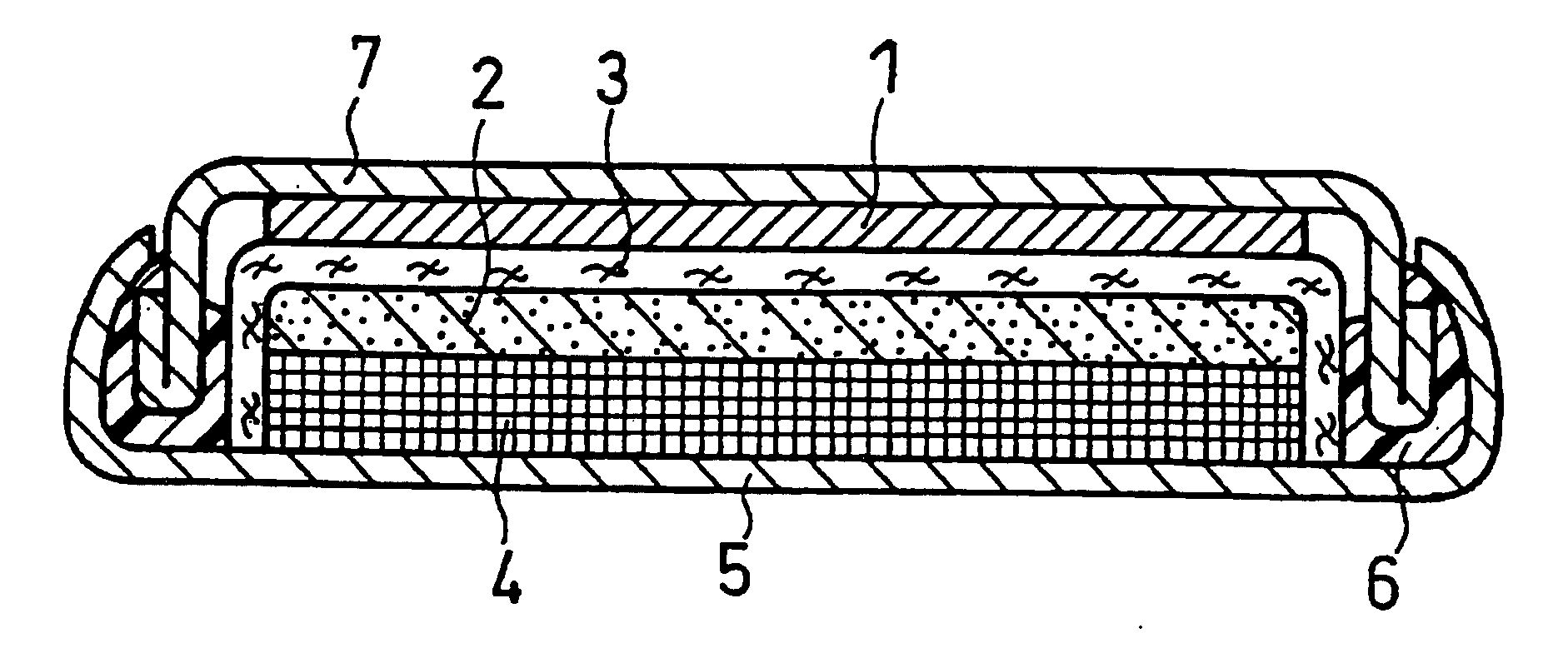Negative electrode for lithium ion secondary battery, method for producing the same, lithium ion secondary battery and method for producing the same
a secondary battery and negative electrode technology, applied in the field of lithium ion secondary batteries, can solve the problems of difficult to achieve a further significant increase in energy density, and the volume change of active materials comprising the above-described new materials is great, and achieves excellent cycle characteristics
- Summary
- Abstract
- Description
- Claims
- Application Information
AI Technical Summary
Benefits of technology
Problems solved by technology
Method used
Image
Examples
example 1
(i) Production of Negative Electrode
[0062]A Ti—Si alloy (Ti: 37 wt %, Si 63 wt %) serving as a negative electrode active material was prepared by a mechanical alloying process. An analysis of the resulting alloy by an electron diffraction method using a transmission electron microscope apparatus confirmed that it was an alloy comprising two phases of TiSi2 and Si.
[0063]A negative electrode material mixture including the Ti—Si alloy powder (average particle diameter 10 μm), a powder of a binder and a conductive agent was sufficiently mixed with water serving as a liquid dispersion medium to prepare a negative electrode material mixture slurry. Acetylene black was used as the conductive agent. The resin materials listed in Table 1 were used as the binder.
[0064]Here, the content of an acrylic acid unit included in the ethylene-acrylic acid copolymer, the content of a methacrylic acid unit included in the ethylene-methacrylic acid copolymer, the content of an acrylic acid unit included ...
example 2
[0079]Batteries B1 to B9 and Batteries C1 to C9 were produced in the same manner as with Batteries A2 and A3 of Example 1, except that the contents of the acrylic acid unit and the methacrylic acid unit in the ethylene-acrylic acid copolymer and the ethylene-methacrylic acid copolymer were varied as shown in Table 2 (85 mol %, 82 mol %, 80 mol %, 60 mol %, mol %, 10 mol %, 4 mol %, 3 mol % or 2 mol %). The obtained batteries were evaluated in the same manner as in Example 1. The results are shown in Table 2.
TABLE 2Binder: Ethylene-acrylic acid copolymerAcrylic acid unitInitial capacityCapacity retentionBatterycontent (mol / %)(mAh)rate (%)B18510.877B28210.980B38010.986B46010.990B54010.990B61010.989B7410.887B8310.778B9210.575Binder: Ethylene-methacrylic acid copolymerMethacrylic acid unitInitial capacityCapacity retentionBatterycontent (mol / %)(mAh)rate (%)C18510.771C28210.876C38010.985C46010.989C54010.990C61010.989C7410.787C8310.678C9210.575
[0080]When the content of the acrylic acid un...
example 3
[0081]Batteries D1 to D6 and Batteries E1 to E6 were produced in the same manner as with Batteries A2 and A3 of Example 1, except that the amount of the ethylene-acrylic acid copolymer or the ethylene-methacrylic acid copolymer occupying the negative electrode material mixture (i.e., the total of the Ti—Si alloy, the binder and the conductive agent) was varied as shown in Table 3 (30 wt %, 25 wt %, 20 wt %, 1 wt %, 0.5 wt % or 0.3 wt %). The amounts of the Ti—Si alloy and the conductive agent were the same as those in Example 1. The obtained batteries were evaluated in the same manner as in Example 1. The results are shown in Table 3.
TABLE 3Binder contentInitial capacityCapacity retentionBattery(wt / %)(mAh)rate (%)Binder: Ethylene-acrylic acid copolymerD1305.792D2258.691D32010.490D4110.987D50.510.685D60.310.372Binder: Ethylene-methacrylic acid copolymerE1305.591E2258.590E32010.389E4110.987E50.510.685E60.310.273
[0082]When the contents of the ethylene-acrylic acid copolymer and the eth...
PUM
| Property | Measurement | Unit |
|---|---|---|
| Temperature | aaaaa | aaaaa |
| Temperature | aaaaa | aaaaa |
| Temperature | aaaaa | aaaaa |
Abstract
Description
Claims
Application Information
 Login to View More
Login to View More - R&D
- Intellectual Property
- Life Sciences
- Materials
- Tech Scout
- Unparalleled Data Quality
- Higher Quality Content
- 60% Fewer Hallucinations
Browse by: Latest US Patents, China's latest patents, Technical Efficacy Thesaurus, Application Domain, Technology Topic, Popular Technical Reports.
© 2025 PatSnap. All rights reserved.Legal|Privacy policy|Modern Slavery Act Transparency Statement|Sitemap|About US| Contact US: help@patsnap.com


